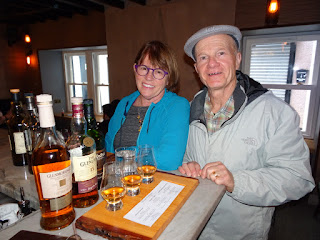 "You're going to Scotland? Then you must go to to the Isle of Skye!" That was the advice we received from people who have been here or live in the UK. They were right, we did, and we're so glad.
"You're going to Scotland? Then you must go to to the Isle of Skye!" That was the advice we received from people who have been here or live in the UK. They were right, we did, and we're so glad.The Isle is the largest NW island of the inner Hibrides islands, accessed by a 40 minute ferry in the south or a five minute bridge crossing in the north. It's dominated by spectacular mountains, lakes, and seashores.
 |
| About the same latitude as Anchorage, AK. Sun doesn't set until 10:00 pm, rises at 4:58 am. |
It has settlements dating back to the bronze age and the Vikings. In the late 1800's over 20,000 people lived here, now only about 10,000 and many more sheep. B&Bs, although fully booked, seem to be everywhere.
The roads are rough, winding, and narrow, often just one lane with turnouts. But the traffic is lighter than the mainland and most drivers are courteous. The sheep are oblivious to vehicles. No matter what, the views at every turn (even the blind curves) are stunning.
We mostly drove around, soaking up the magnificent scenery. We visited the Dunvegan Castle, home of the McLeod Clan, for hundreds of years, and today.
 |
| Dunvegan Castle, still occupied over the past 400 years |
 |
| The Old Man of Storr |
Life was unbelievably hard then, as it was for rural dwellers everywhere. Many left to become American homesteaders.
 |
| A 'crofter' home, occupied over 100 years until 1954 |
 |
| High heals don't work well on cattle guards! |
 |
| Our trusty Peugeot steed and our B&B cottage |
The drive over the bridge to the mainland and on to Inverness was long and intense, but the scenery continued to astound us as did Loch Ness and tantalizing glimpses of castles where we were waved on because there was no more parking.
 |
| Roadside scenery on the way to Inverness |
 |
| A castle we couldn't get close to because of the weekend crowds. So we drove up a farm road to get this view. |
We loved Inverness, settled sometime around 500 AD. We're glad we watched a few episodes of Outlander before we left home, as it gave us a little background of the history here, especially regarding events leading up to the April 1745 Jacobite rebellion and the Battle of Culloden. We enjoyed a guided tour of the battle field and all of the causes of the battle, in which the Jacobites were slaughtered. We wondered if we may not have had the Revolutionary War if the French-backed Jacobites had won.
 |
| Museum & battlefield of Culloden |
 |
| Each extended brick represents one of the 1500 Jacobite fighters killed in matter of minutes. Only 50 British soldiers were killed, but 200 died of wounds later. |
 |
| The 3,000-year old Clava Carins. (No, we didn't see Clair Beecham or any other Outlander cast members.) |
Nearby was Fort George, a huge military fortress that took 20 years to build after the Culloden battle. It's still a working military base, but overall pretty useless in this modern era. Nevertheless, the history, tour, and even the dog cemetery were fascinating.
 |
| Ft. George, Completed in 1765, still occupied today |
 |
| Downward Dog Kathy at the Ft. George dog cemetery |
 |
| Smiling before a scotch tasting in Inverness. Not smiling afterwards. |
 |
| Atop a castle tower, that is now part of city hall. |
After four hours of freeway driving with average speed cameras ready to issue a ticket, we reached Edinburgh and gladly turned in our rental car, proud to have survived without even a scratch. More about Edinburgh in Part III. Meanwhile enjoy the photo links below.
Link to our best shots of the Isle of Skye.
Link to our best shots of the Inverness area.
No comments:
Post a Comment